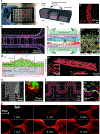Engineering Organ-on-a-Chip Systems for Vascular Diseases
- PMID: 37823265
- PMCID: PMC10842627
- DOI: 10.1161/ATVBAHA.123.318233
Engineering Organ-on-a-Chip Systems for Vascular Diseases
Abstract
Vascular diseases, such as atherosclerosis and thrombosis, are major causes of morbidity and mortality worldwide. Traditional in vitro models for studying vascular diseases have limitations, as they do not fully recapitulate the complexity of the in vivo microenvironment. Organ-on-a-chip systems have emerged as a promising approach for modeling vascular diseases by incorporating multiple cell types, mechanical and biochemical cues, and fluid flow in a microscale platform. This review provides an overview of recent advancements in engineering organ-on-a-chip systems for modeling vascular diseases, including the use of microfluidic channels, ECM (extracellular matrix) scaffolds, and patient-specific cells. We also discuss the limitations and future perspectives of organ-on-a-chip for modeling vascular diseases.
Keywords: endothelial cells; hemodynamics; microfluidics; microphysiological systems; vascular diseases.
Conflict of interest statement
Figures


Similar articles
-
Recent developments in organ-on-a-chip technology for cardiovascular disease research.Anal Bioanal Chem. 2023 Jul;415(18):3911-3925. doi: 10.1007/s00216-023-04596-9. Epub 2023 Mar 3. Anal Bioanal Chem. 2023. PMID: 36867198 Review.
-
Latest developments of microphysiological systems (MPS) in aging-related and geriatric diseases research: A review.Ageing Res Rev. 2025 May;107:102728. doi: 10.1016/j.arr.2025.102728. Epub 2025 Mar 7. Ageing Res Rev. 2025. PMID: 40058462 Review.
-
Microfluidics and Organ-on-a-Chip for Disease Modeling and Drug Screening.Biosensors (Basel). 2024 Feb 4;14(2):86. doi: 10.3390/bios14020086. Biosensors (Basel). 2024. PMID: 38392005 Free PMC article.
-
Recent progress of organ-on-a-chip towards cardiovascular diseases: advanced design, fabrication, and applications.Biofabrication. 2023 Jul 4;15(4). doi: 10.1088/1758-5090/acdaf9. Biofabrication. 2023. PMID: 37267929 Review.
-
Applications of Microfluidics and Organ-on-a-Chip in Cancer Research.Biosensors (Basel). 2022 Jun 27;12(7):459. doi: 10.3390/bios12070459. Biosensors (Basel). 2022. PMID: 35884262 Free PMC article. Review.
Cited by
-
Microfluidic Chip for Quantitatively Assessing Hemorheological Parameters.Micromachines (Basel). 2025 May 8;16(5):567. doi: 10.3390/mi16050567. Micromachines (Basel). 2025. PMID: 40428693 Free PMC article.
-
Use of iPSC-Derived Smooth Muscle Cells to Model Physiology and Pathology.Arterioscler Thromb Vasc Biol. 2024 Jul;44(7):1523-1536. doi: 10.1161/ATVBAHA.123.319703. Epub 2024 May 2. Arterioscler Thromb Vasc Biol. 2024. PMID: 38695171 Free PMC article. Review.
-
Bioengineered human arterial equivalent and its applications from vascular graft to in vitro disease modeling.iScience. 2024 Oct 19;27(11):111215. doi: 10.1016/j.isci.2024.111215. eCollection 2024 Nov 15. iScience. 2024. PMID: 39555400 Free PMC article. Review.
-
Lab-on-a-chip models of cardiac inflammation.Biomicrofluidics. 2024 Oct 29;18(5):051507. doi: 10.1063/5.0231735. eCollection 2024 Sep. Biomicrofluidics. 2024. PMID: 39483204 Review.
-
Bridging the Gap: Endothelial Dysfunction and the Role of iPSC-Derived Endothelial Cells in Disease Modeling.Int J Mol Sci. 2024 Dec 11;25(24):13275. doi: 10.3390/ijms252413275. Int J Mol Sci. 2024. PMID: 39769040 Free PMC article. Review.
References
-
- Liu Y, Lin L, Qiao L. Recent developments in organ-on-a-chip technology for cardiovascular disease research. Analytical and Bioanalytical Chemistry 2023:1–15. - PubMed
-
- Thondapu V, Bourantas CV, Foin N, Jang I-K, Serruys PW, Barlis P. Biomechanical stress in coronary atherosclerosis: emerging insights from computational modelling. European heart journal 2017;38:81–92. - PubMed
Publication types
MeSH terms
Grants and funding
LinkOut - more resources
Full Text Sources
Medical

